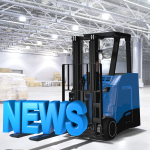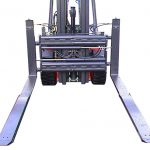The 3D animation presents an interesting comparison showing the differences between a reach truck with single pantograph, (scissors type), reach mechanism and a reach truck with KOOI-REACHFORKS®, (Single Range hydraulic extendable lift truck forks).
KOOI-REACHFORKS® offer distinct advantages when compared to pantograph type reach mechanisms and they provide greater value to the end user:
1. Easy pallet entry
2. Equivalent speed
3. Superior residual capacity
4. Better visibility
5. Comparable compensation for deflection
6. Fewer maintenance points
7. Easier to replace, (or transfer to another truck)
8. More adaptability – can be used with a fork positioner/spreader
9. Greater versatility, (provide safe support of differing pallet sizes)
10. Lower investment cost
1. Easy pallet entry.
It’s a given fact telescopic forks are typically thicker, (depending on capacity), than standard forks however, this does not hinder their ability for pallet handling. The most common KOOI-REACHFORKS® forks thickness is just 57mm, (2.24”), in this comparison, lifting 2000 kg, (4,400 Lbs.), extended.
2. Equivalent speed.
With the Single Range telescopic forks we have the same cycle speed as the pantograph which is approximately 5 seconds in/out with an extension of 610 mm (24”).
3. Superior residual capacity.
Physical weight or mass of the pantograph mechanism is far greater, (900 kg or 1800 Lbs.), than the telescopic forks, (145 kg or 320 Lbs.). The pantograph must extend the fork carriage, forks and suspension arms along with the load whereas the telescopic forks merely extend the outer fork sleeves with the load. Therefore, this major difference in mass provides the advantage of greater residual capacity with KOOI-REACHFORKS®. An additional benefit relates to improved maneuvering clearance as the trucks turning circle can be reduced with telescopic forks as the length of the trucks supporting legs, (straddle legs), can also be reduced.
4. Better visibility.
The KOOI-REACHFORKS® only extend the outer forks so they do not hinder visibility. The pantograph extends the forks, fork carriage and suspension arms which has a negative effect on visibility (Safety).
5. Comparable compensation for deflection.
The compensation for deflection is about the same on both types of reach mechanisms. Because standard lift truck forks are thinner they have relatively more deflection however, the total extended length of telescopic forks is greater so they become comparable. Using a tangent formula the compensation through the tilt function is equal.
6. Fewer maintenance points.
Both mechanisms utilize hydraulic cylinders and even though they are completely integrated inside the inner forks, on the telescopic forks, these components are about equal. The major difference has to do with the “wearable” moving components. A pantograph has numerous rollers, bearings, suspension arms and hinge points. These are all wearable items which require extra maintenance. The telescopic forks simply extend the internal pistons and outer fork sleeves.
7. Easier to replace.
If the customer wants to exchange a reach mechanism, it will take much more time and money to remove the pantograph unit compared to the KOOI-REACHFORKS® which mount just like standard lift truck forks, with the exception of two additional hydraulic hoses.
8. More adaptability.
With a pantograph mechanism, the fork carriage is mounted in front and moves with the unit, (point #3). When a forks-positioner or spreader is required, it too, must be mounted out front so it moves with the carriage. The extra weight applied to the fork carriage along with the movement has an enormous effect and drastically reduces residual capacity. In the same case using KOOI-REACHFORKS®, the fork positioner mounts to the carriage close to the supporting upright or lift truck mast and it remains in place. There is far less effect on residual capacity.
9. Greater versatility.
When using KOOI-REACHFORKS (hydraulic versions or mechanical extensions) you have the possibility to extend the forks to a certain length complying to the pallet depth at hand. When handling different pallet sizes, this is a tremendous advantage because damage can be reduced. Both product and pallet damage are minimized and of course the forks provide safe support for differing load sizes.
10. Lower investment cost.
It only takes a simple calculation to reveal an enormous difference in mass, complexity, parts and production hours between the two reach mechanisms. Simply put, the pantograph is far more expensive to produce, operate and maintain.











